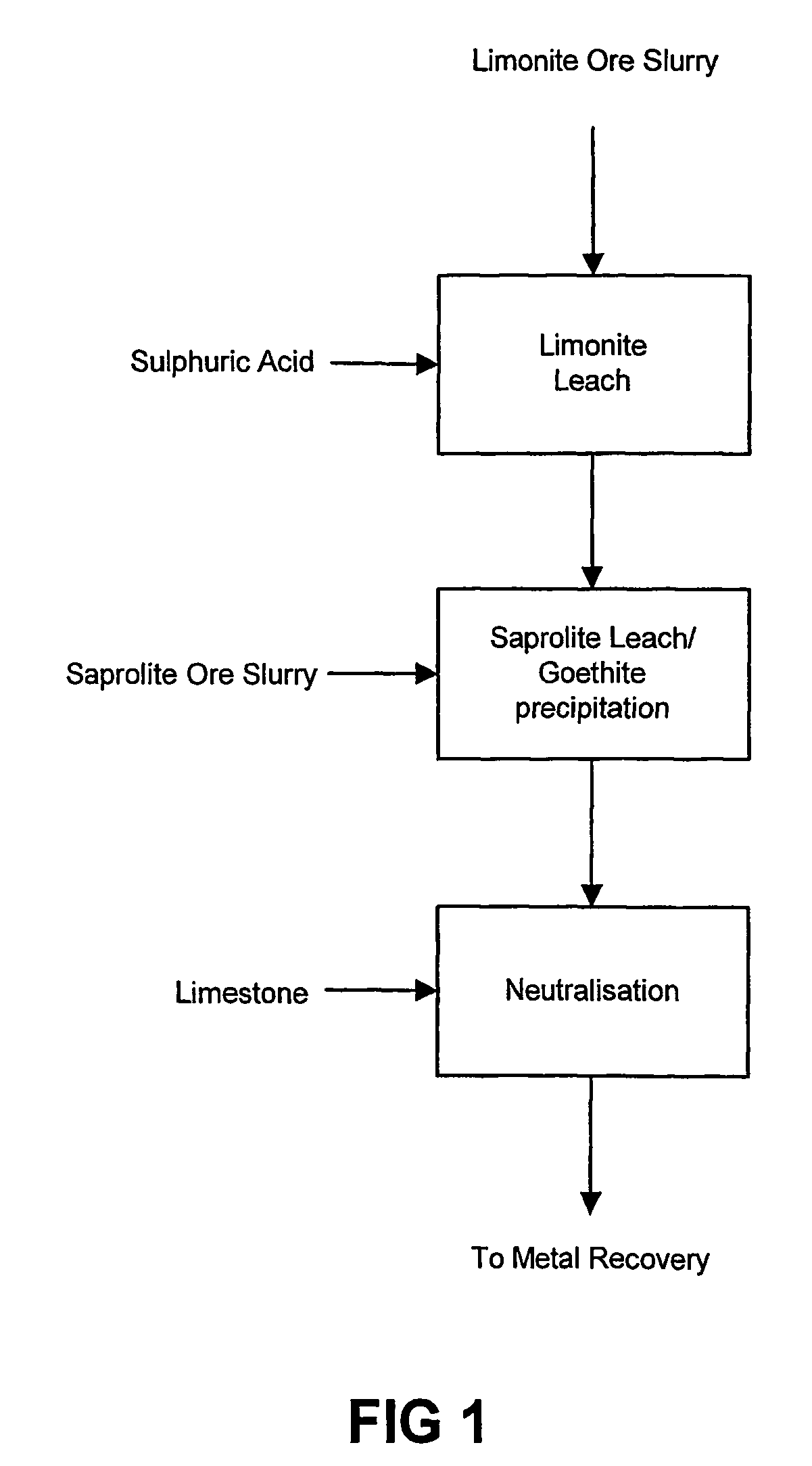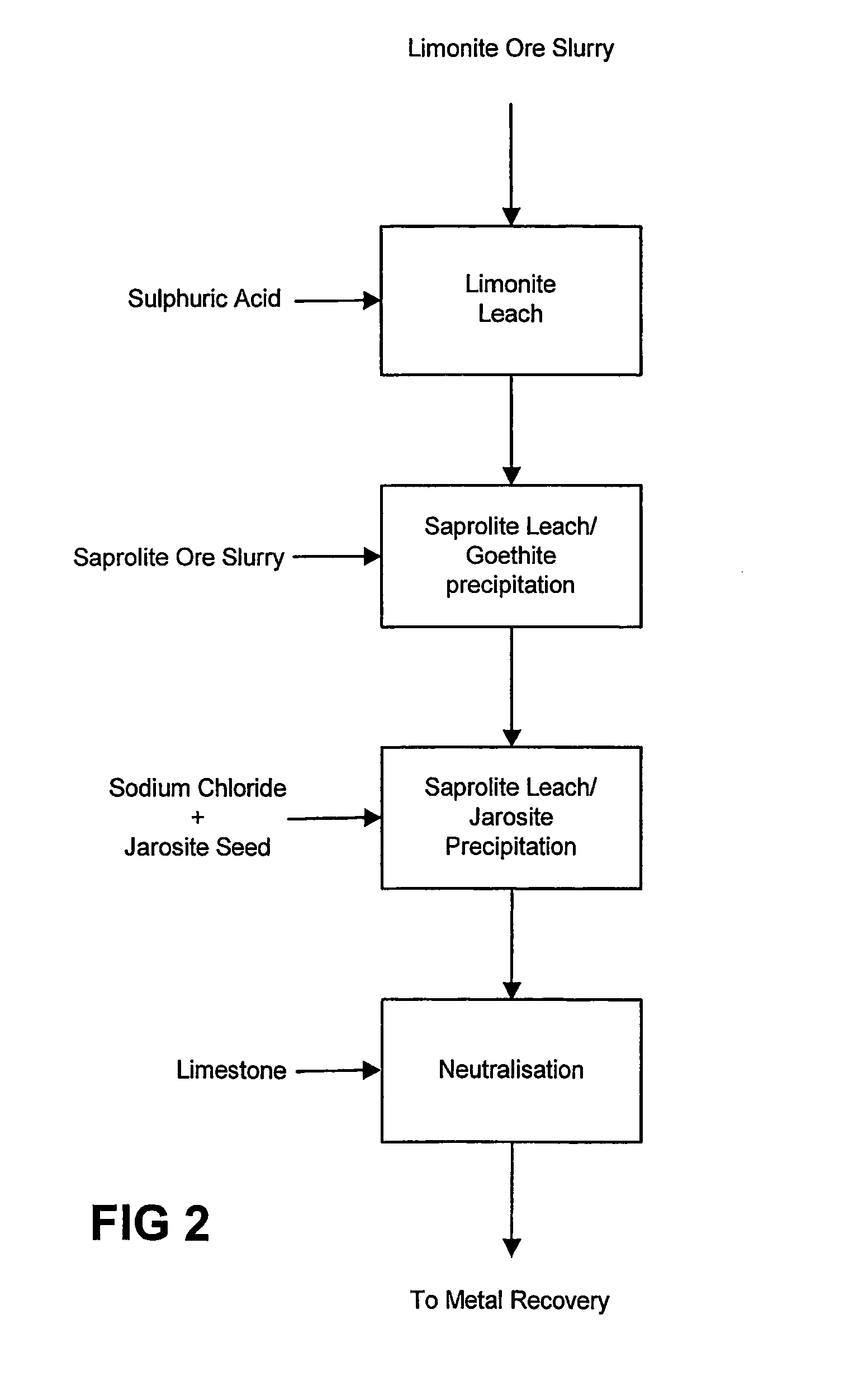Atmospheric pressure leach process for lateritic nickel ore
a technology of atmospheric pressure and leaching process, which is applied in the direction of nickel compounds, cobalt compounds, inorganic chemistry, etc., can solve the problems of high pressure and temperature operating conditions, inability to achieve effective methods, and inability to solubilize nickel and cobalt from dissolved iron,
- Summary
- Abstract
- Description
- Claims
- Application Information
AI Technical Summary
Benefits of technology
Problems solved by technology
Method used
Image
Examples
example 2
[0052]The low magnesium laterite ore (Mg wt %8) laterite ore eg saprolite slurry, were separately prepared with potable water. The iron content of the saprolite ore used was 18 wt %. The solid concentrations of limonite and saprolite slurry were 20 wt % and 25 wt % respectively. The weight ratios of sulfuric acid / limonite, saprolite / limonite and sulfuric acid / ore (limonite and saprolite) were 1.36, 0.88 and 0.72 respectively. In this test 934 grams 20 wt % limonite slurry was mixed with 267 grams 98 wt % H2SO4 in a reactor at the temperature of 95 to 105° C. and atmospheric pressure for 2.5 hours. The leachate contained 23 g / L H2SO4, 3.0 g / L Ni, 84 g / L Fe, 1.9 g / L Mg and 0.24 g / L Co. The redox potential was controlled between 835 to 840 mV (SHE) by adding sodium-free sulphite. After the acidity was stabilised around 26 g / L H2SO4, 673 grams 25 wt % saprolite slurry and 80 grams of goethite containing seeds were consecutively added into the reactor. The reaction of saprolite leaching ...
example 3
[0054]In this test the weight ratios of sulfuric acid / limonite, saprolite / limonite and sulfuric acid / ore (limonite and saprolite) were 1.37, 0.69 and 0.81 respectively. 935 grams 20 wt % limonite slurry described in Example 2 was mixed with 267 grams 98 wt % H2SO4 in a reactor at the temperature of 95 to 105° C. and atmospheric pressure for 3 hours. The leachate contained 24 g / L H2SO4, 2.8 g / L Ni, 77 g / L Fe, 1.9 g / L Mg and 0.21 g / L Co. The redox potential was controlled between 835 to 840 mV (SHE) by adding sodium-free sulphite. After the acidity stabilised around 26 g / L H2SO4, 524 grams 25 wt % saprolite slurry described in Example 2 and 80 grams goethite containing seeds were consecutively added into the reactor. The reaction of saprolite leaching and iron precipitation was carried out at 95 to 105° C. and atmospheric pressure for 10 hours. The redox potential was 720 to 800 mV (SHE) without adding the sodium-free sulphite. The leachate containing 3 g / L H2SO4, 3.5 g / L Ni, 27.4 g / L...
example 4
[0056]In this test the weight ratios of sulfuric acid / limonite, saprolite / limonite and sulfuric acid / ore (limonite and saprolite) were 1.37, 0.58 and 0.87 respectively. 935 grams 20 wt % limonite slurry described in Example 2 was mixed with 267 grams 98 wt % H2SO4 in a reactor at the temperature of 95 to 105° C. and atmospheric pressure for 3 hours. The leachate contained 24 g / L H2SO4, 3.3 g / L Ni, 92 g / L Fe, 2.1 g / L Mg and 0.24 g / L Co. The redox potential was controlled between 840 to 850 mV (SHE) by adding sodium-free sulphite. After the acidity stabilised around 25 g / L H2SO4, 440 grams 25 wt % saprolite slurry described in Example 2 and 80 grams goethite containing seeds were consecutively added into the reactor. The reaction of saprolite leaching and iron precipitation was carried out at 95 to 105° C. and atmospheric pressure for 11 hours. The redox potential was 800 to 840 mV (SHE) without adding the sodium-free sulphite. The leachate contained 4 g / L H2SO4, 3.5 g / L Ni, 35.1 g / L ...
PUM
| Property | Measurement | Unit |
|---|---|---|
| temperature | aaaaa | aaaaa |
| boiling point | aaaaa | aaaaa |
| temperatures | aaaaa | aaaaa |
Abstract
Description
Claims
Application Information
 Login to View More
Login to View More - R&D
- Intellectual Property
- Life Sciences
- Materials
- Tech Scout
- Unparalleled Data Quality
- Higher Quality Content
- 60% Fewer Hallucinations
Browse by: Latest US Patents, China's latest patents, Technical Efficacy Thesaurus, Application Domain, Technology Topic, Popular Technical Reports.
© 2025 PatSnap. All rights reserved.Legal|Privacy policy|Modern Slavery Act Transparency Statement|Sitemap|About US| Contact US: help@patsnap.com



